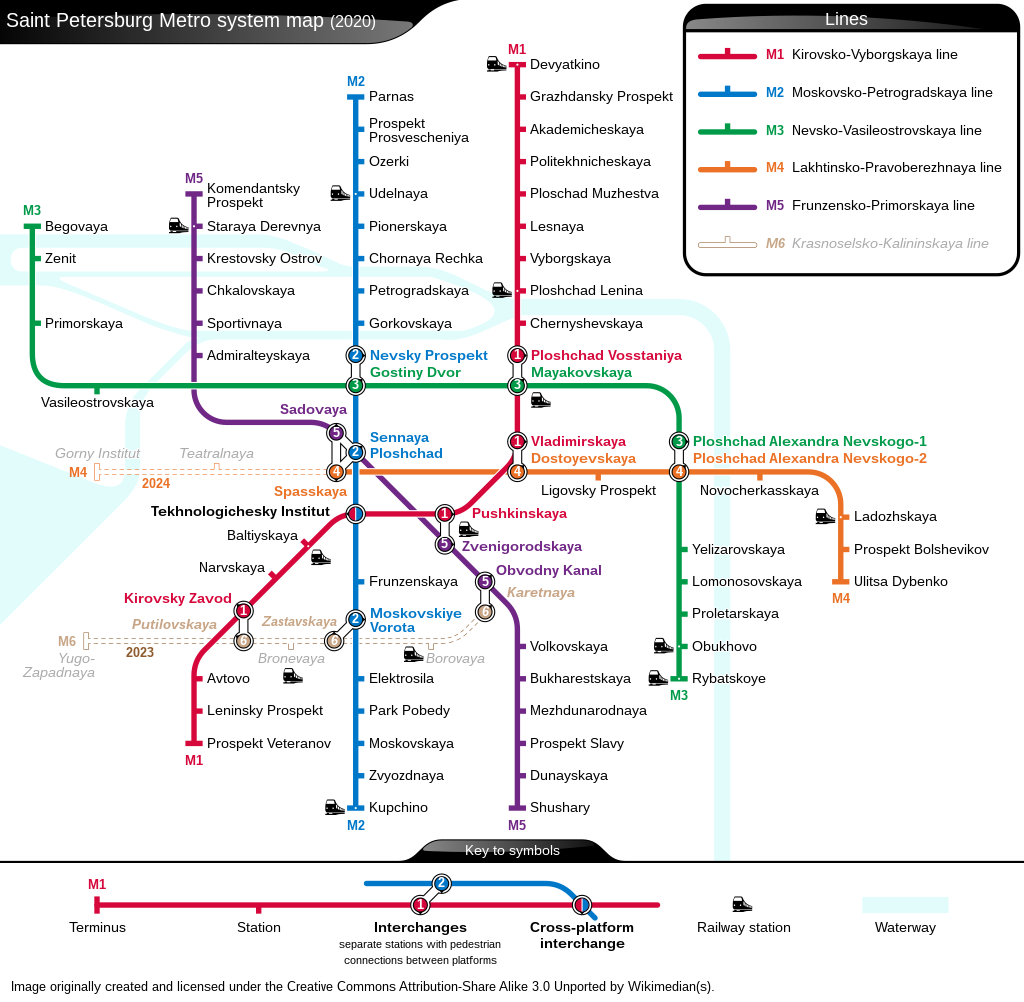One of the most stunning cities in the world, Saint Petersburg has one of the best public transport systems in all of Europe. Buses, trams, trolleybuses, metro lines, and commuter trains are well-connected throughout the city. The Saint Petersburg Metro is in charge of all public transportation. The city’s metro lines, which link all the major sights and the suburbs, are the most practical means of transport. Public transport fares are reasonably priced, and monthly passes are offered to frequent users. Additionally, the city has an excellent network of taxis, and automobile rental services are also offered.
Metro system in Saint Petersburg – Basic information
The second-oldest rapid transport system in the world is the metro in Saint Petersburg. The Saint Petersburg Metro system, which was first used in 1955, consists of five lines, 72 stations, and a total of 124.8 kilometers of track. With some stations more than 80 metres down, it is one of the world’s deepest metro networks. Additionally, the Saint Petersburg Metro features some of the most exquisite stations in the entire world, complete with elaborate artwork and décor. With trains running from 6 am to 1 am, it is one of the most effective and dependable transport networks in the city.
The lines of the Saint Petersburg subway system
Line 1 (Kirovsko-Vyborgskaya)
The Red Line or Kirovsko-Vyborgskaya Line is the oldest subway line in St. Petersburg, Russia, connecting Kirovsky and Vyborgsky neighborhoods. The line has beautifully decorated stations like Avtovo and Narvskaya and connects four of the city’s five major train stations. It runs through the city center on a northeast-southwest axis, following the coastline of the Gulf of Finland. A tunnel flood in 1995 caused the line to split into two sections for nine years. The Kirovsko-Vyborgskaya Line and the Nevsko-Vasileostrovskaya Line are the only two in the network with shallow stations. The line is highlighted in red on metro maps and new trains have been painted in the same color since the 2010s. It crosses the city boundary only in the north, continuing into the Leningrad oblast.
Line 2 (Moskovsko-Petrogradskaya)
Line 2 of the St. Petersburg Metro, also known as the Moskovsko-Petrogradskaya Line or Blue Line, is the second-oldest rapid transit line in the city. It was established in 1961 and connects the city center with the northern and southern suburbs. The line includes the USSR’s first cross-platform transfer and introduced a unique type of platform called the “Horizontal Lift.” Running on a north-south axis, the line is depicted as blue on Metro maps. It became the longest line in the system in 2006 with the opening of an extension.
Line 3 (Nevsko-Vasileostrovskaya)
The Nevsko-Vasileostrovskaya Line, also known as Line 3 or the Green Line is a rapid transit line in Saint Petersburg, Russia, that connects the city center with the western and southeastern regions. It was established in 1967 and is known for having the longest inter-station tunnels in the entire metro system and stations that are all of the “Horizontal Lift” type. While metro officials had initially planned to build new stations between existing ones, those plans were eventually abandoned. The line runs on an east-west axis through the heart of Saint Petersburg before turning southeast to follow the left bank of the Neva River. It is typically colored green on Metro maps.
Line 4 (Lakhtinsko-Pravoberezhnaya)
The Orange Line, also known as Line 4, is a rapid transit line in Saint Petersburg, Russia that connects the city center with the southeast areas on the left bank of the Neva River. Despite its name, it has no stations near the Lakhta area. It is the shortest line and was opened in 1985. Its stations have a contemporary style. The line was initially built to give access to the new residential communities along the right bank of the Neva. Due to construction delays, a northern section of Line 5 was temporarily connected to Line 4. When Spasskaya station was completed in 2009, it became the new terminal for Line 4, and Line 5 was built according to the original plan.
Line 5 (Frunzensko-Primorskaya)
Line 5 of the Saint Petersburg Metro, also known as Frunzensko-Primorskaya Line or Purple Line, opened in 2008 and connects the city center to northwestern and southern districts. It initially had only two stations but expanded to nine in 2009 with the incorporation of six existing stations from Line 4. Admiralteyskaya station, one of the deepest stations in the world at 86 meters, opened in 2011. It is named after the Primorsky district and Russian Bolshevik commander Mikhail Frunze.
Line 6 (Krasnosel’sko-Kalininskaya)
The Krasnoselsko-Kalininskaya line, also known as line 6, is a new passenger rapid transit line of the Saint Petersburg Metro system with a brown livery. It is currently under construction, with train service set to begin in 2024 with two stations initially and four more stations later in 2026 or 2027. The line travels from Krasnoselsky District northeastward and includes interchange stations with lines 1, 2, and 5. Future plans include extending the line further into Kalininsky District.
Map of Saint Petersburg Metro 2023 – Free Download in PDF

Click on the image and download the map of Saint Petersburg´s underground system for 2023
For all visitors to the city, the Saint Petersburg Metro 2023 map is a necessity. This map is easily accessible on any device and is available as a free PDF download. Visitors may simply navigate the city because it has all the important stations and all the connecting lines. Important sites like the Hermitage Museum and the Church of the Saviour on Spilled Blood are also depicted on the map. The Saint Petersburg Metro 2023 map makes it simple for visitors to navigate the city and take in all of its many attractions.
Public transport tickets in Saint Petersburg – Best types for travelers & actual prices
Visitors to Saint Petersburg have a wide range of options for moving around the city thanks to the public transport system. There are tickets for every budget and travel requirement, including bus and tram tickets as well as single-ride and multi-ride passes.
Tickets for buses and trams can be bought straight from the driver as you board. A 25 RUB ticket is good for one ride on that specific bus or tram only. At any of the city’s ticket booths, a multi-ride pass that includes 10 rides can be purchased for 200 RUB.
Tickets for a single ride and several rides are also available on the Saint Petersburg Metro. Tickets for a single ride must be purchased at one of the Metro stations and cost 50 RUB. There are two types of multi-ride tickets: a thirty-ride pass costs 500 RUB, and a sixty-ride pass costs 900 RUB.
The Saint Petersburg Card is the most practical choice for those who will be in Saint Petersburg for three days. This 72-hour pass provides access to all municipal transport services as well as savings on a number of the city’s attractions. At any of the city’s ticket booths, the Saint Petersburg Card can be purchased for 950 RUB.
Tickets for Saint Petersburg’s public transit are available to suit any budget or travel requirement. Everyone can choose from single-ride tickets to multi-ride passes. The Saint Petersburg Card, which provides access to all of the city’s public transport as well as discounts to many of the city’s attractions, is the best choice for those who are only in town for three days.
Summary of fares for public transport in Saint Petersburg
- Bus and tram tickets can be purchased directly from the driver for 25 RUB for a single ride or from a ticket booth for 200 RUB for ten rides.
- A single Metro journey costs 50 RUB, while 30 or 60-ride multi-ride cards are available for 500 RUB and 900 RUB, respectively.
- The Saint Petersburg Card costs 950 RUB and entitles holders to discounts on city attractions as well as access to all municipal transport systems.
Timetables & Schedules of Saint Petersburg Metro system
From Monday through Sunday, the Saint Petersburg Metro system is open from 5:30 am until 2:30 am. The trains run every 2-3 minutes during peak hours and every 5-7 minutes during off-peak hours. Additionally, the Metro includes express lines that run every ten minutes from 6:00 am to 11:00 pm. The Metro system shuts down at 11:00 p.m. on holidays, and trains run every 30 minutes after midnight during late hours. A typical rail trip takes no longer than 25 minutes and all trains travel in the same direction.
What Are Other Options For Public Transportation In Saint Petersburg?
Saint Petersburg offers a wide range of options for public transit. There are a number of alternative ways to move around the city, while the metro is the most well-liked. The many modes of public transport in Saint Petersburg are shown below.
Bus: Saint Petersburg has a robust public bus system that travels throughout the majority of the city. The buses are a reliable kind of transportation that can take you almost anywhere in the city. Wheelchair lifts are a common feature on buses, and many have bike racks as well.
Trolleybus: Trolleybuses are similar to buses but they operate on electricity lines that are above the ground. Saint Petersburg residents frequently use this form of public transport since it is dependable and reasonably priced.
Tram: Another well-liked mode of public transit in the city is the tram. The trams are a speedy and convenient way to navigate about town compared to buses.
Boat: One of Saint Petersburg’s most distinctive modes of public transit is the boat. The Neva River can be crossed by boat, and city tours are also available.
Bicycle: Cycling is growing in popularity in Saint Petersburg, and the city has a variety of bike tracks and trails that make getting about the city simple. There are numerous outlets all across the city where you can hire bicycles.
Just a few of Saint Petersburg’s public transit alternatives are listed above. There is bound to be one that suits your needs among the countless options. Saint Petersburg offers a variety of options for everyone searching for an easy, quick method to move around or an inexpensive way to explore the city.
How To Get From Saint Petersburg Airport (lED) To The City Center With Public Transport?
Russia’s Saint Petersburg might be a fascinating place to visit. The airport is situated just outside the city center, and the city is full of amazing attractions and things to do. You’ll need to know how to use public transportation to travel from Saint Petersburg Airport to the city centre whether you’re staying a short while or a while.
The easiest ways to get to the Saint Petersburg Airport are by train or bus, which are about 30 kilometres from the city centre. Several public transport lines, such as the Aeroexpress, which leaves the airport every 30 minutes, are available for use at the airport. The train ride costs roughly 500 rubles and lasts about 40 minutes.
As an alternative, you can ride a bus into the city center from the airport. The #39 and #K39 are two of the bus routes that provide direct service between the airport and the city centre. Both of these buses cost roughly 100 rubles and run every 30 minutes. It takes an hour or so to get there.
You can take a taxi from the airport to the city centre if you want a quicker and more practical choice. You can take a taxi from the airport to the city center in about 30 minutes. A cab ride normally costs roughly 1,500 rubles.
Regardless of the route you take, it is simple and convenient to go from Saint Petersburg Airport to the city centre. The trip is convenient and reasonably priced whether you use the bus, train, or taxi. You can quickly take advantage of the best that Saint Petersburg has to offer with these selections.
What kind of sightseeing do you have to see if you visit Saint Petersburg for the first time?
Russia’s Saint Petersburg is a fascinating travel destination that gives visitors an in-depth look at the history and culture of the nation. Saint Petersburg is a city unlike any other because of its opulent architecture, magnificent cathedrals, and network of canals and bridges. There are several must-see sights in this magnificent city that should not be skipped when making travel plans.
One of Saint Petersburg’s most popular sights, the Hermitage Museum ought to be at the top of every traveler’s itinerary. This enormous museum is one of the biggest and most magnificent art museums in the world, housing a significant collection of works of art, artefacts, and historical things. The Hermitage is likely to awe visitors with its collection of Renaissance masterpieces and artefacts from ancient Egypt.
All tourists should visit the Church of the Saviour on Spilled Blood, another well-known attraction in Saint Petersburg. This magnificent Orthodox cathedral is a particularly distinctive sight in the city because of its complex mosaics and vivid colours. For visitors who are interested in learning more about the city and its residents, the chapel serves as a poignant reminder of a tragic episode in its past.
Another well-liked destination in Saint Petersburg and an excellent method to learn about the history of the city is the Peter and Paul Fortress. This ancient castle, which once served as the city’s citadel, is now home to a variety of museums and tourist attractions. The stronghold is a fantastic place to learn about the city and its history, with everything from the Peter and Paul Cathedral to the Grand Ducal Burial Vault.
Another fantastic place to go in Saint Petersburg is the Mariinsky Theatre. The city’s renowned opera and ballet events are held at this ancient theatre, which is also a wonderful location to explore Russian culture and art. The theatre is a must-see for all visitors because of its exquisite architecture and breathtaking performances.
The City Palace must be seen on any visit to Saint Petersburg. The historic home of the Russian Tsars, this magnificent palace offers a fascinating look into the area’s regal past. The palace is now a great destination to explore with a number of museums and galleries.
Saint Petersburg is a compelling location that shouldn’t be missed, with its opulent architecture, magnificent cathedrals, and canals and bridges. The city provides a variety of attractions that are sure to make any visit unforgettable, from the Hermitage Museum to the City Palace. Saint Petersburg has something for everyone, whether you’re interested in history, culture, or art.
What other metro systems are nearby to Saint Petersburg?
Saint Petersburg is a bustling city with a lot to explore and experience. One of the best ways to get around Saint Petersburg is by taking its metro system. But did you know that there are other metro systems in the area that can be accessed from Saint Petersburg?
The Moscow Metro is the most well-known metro system in Russia and can be accessed from Saint Petersburg. It is the oldest and busiest metro system in Russia, and it has been operating since 1935.
The Nizhny Novgorod Metro is another nearby metro system to Saint Petersburg. It serves the city of Nizhny Novgorod and is a great way to get to and from Saint Petersburg. Finally, the Kazan Metro is another nearby metro system to Saint Petersburg. It was opened in 2005 and is the fourth busiest metro system in the country.
Summary of our tour guide for Saint Petersburg
An energetic city called Saint Petersburg can be found along the Gulf of Finland. It is a city rich in history and culture with its interesting blend of ancient and modern buildings, museums, cathedrals, and canals. Saint Petersburg has an extensive network of metro, bus, and trolleybus lines, as well as trams, boats, and taxis, making public transportation dependable and effective. It is simple to go around the city and discover its various attractions thanks to the accessibility of all these modes of transport.
Top 5 FAQs and answers about Saint Petersburg public transport?
Which form of public transit is the best for getting to Saint Petersburg?
- The metro is the most effective mode of public transport for getting around Saint Petersburg. The most effective and economical method of moving around the city is via the metro. Additionally, it is the quickest method of traveling from A to B. With five lines and more than 70 stops, the metro system makes it simple to go to practically any location inside the city.
How much does using public transport in Saint Petersburg cost?
- Depending on the type of ticket you purchase, utilizing public transport in Saint Petersburg will cost you. Single-ride tickets can be used for one trip on the metro or other modes of public transport and cost about 30 rubles. There are additional tickets that offer discounts and unrestricted travel that are offered on a daily, weekly, and monthly basis.
Does Saint Petersburg provide any other public transit options?
- In addition to the metro, Saint Petersburg has buses, trams, and trolleybuses. All of these are less expensive than the metro, but they also take longer and are less trustworthy. There are water buses as well, which are a fantastic way to travel down the river and see the city.
Is using Saint Petersburg’s public transit safe?
- Yes, using public transit in Saint Petersburg is safe. Police officers are stationed at every metro station, and the system is well-lit and watched over by security cameras. Although you should take additional measures if you are traveling late at night, the other kinds of public transportation are also secure.
How do I pay for Saint Petersburg public transportation?
- In Saint Petersburg, you can use cash or a transit card to pay for public transport. You may load money onto the transit card and use it to pay for your rides, making it a convenient method of payment. Additionally, it is less expensive than using cash.







